- Quick Read
- Deep Read ( 7 Min. )

Why is Christian Science in our name?
Our name is about honesty. The Monitor is owned by The Christian Science Church, and we’ve always been transparent about that.
The Church publishes the Monitor because it sees good journalism as vital to progress in the world. Since 1908, we’ve aimed “to injure no man, but to bless all mankind,” as our founder, Mary Baker Eddy, put it.
Here, you’ll find award-winning journalism not driven by commercial influences – a news organization that takes seriously its mission to uplift the world by seeking solutions and finding reasons for credible hope.
Explore values journalism About usMonitor Daily Podcast
- Follow us:
- Apple Podcasts
- Spotify
- RSS Feed
- Download
TODAY’S INTRO
Pakistan’s secret mango mission
 Howard LaFranchi
Howard LaFranchi
The sweet juices running down my hands from the orangy-yellow Pakistani mangoes were just what the invitation had promised. Come to the mango festival at the Pakistan Embassy, I had been assured, and taste mangoes as you’ve never tasted them before.
Much like other festivalgoers crowded around the trays of ambrosia-like fruit, I was alternating between juicy bites and exclamations of utter deliciousness.
The problem was those sticky hands. I was about to have a pull-aside (diplomatic-speak for a brief meeting on the margins of another event) with two Pakistan officials. And there would be handshakes. So I decided to let the stars of the festival speak – or maybe stick – for themselves. And if either diplomat was bothered by it, neither let on.
That may be because the mango festival had a deeper objective. Ambassador Masood Khan wants Americans to have greater access to what he calls “the king of fruits” – not just any mangoes, but the royal varieties of Pakistan’s Sindh and Punjab provinces.
Currently Pakistan exports less than $1 million in fruity gold to the United States annually. Compare that with the mangoes coming from Mexico last year, worth $400 million. The reason? Not distance, so much. But there’s a Department of Agriculture requirement that all Pakistani mangoes enter the United States at the port of Houston, where the fruit is irradiated to USDA specifications.
Pakistan has responded by building an irradiation facility in Karachi. All it lacks, says Trade Minister Azmat Mahmud, is USDA approval.
I started to grasp the ulterior motive of the trays of luscious fruit arrayed before this Washington crowd. Just maybe, the mangoes’ juicy bliss could accomplish what diplomacy has not yet done. Just maybe, Pakistani officials wanted my fellow festivalgoers to join the clamor for their country’s “king of fruits.” Just maybe, they succeeded.
Share this article
Link copied.

Help fund Monitor journalism for $11/ month
Already a subscriber? Login

Monitor journalism changes lives because we open that too-small box that most people think they live in. We believe news can and should expand a sense of identity and possibility beyond narrow conventional expectations.
Our work isn't possible without your support.
Abortion and Ohio’s fight over direct democracy
With abortion policy now up to states, activists are looking to state constitutions as a way to guarantee or deny rights. And that’s leading to battles over how easily constitutions can be amended.

Across Ohio, activists are urging voters to turn out in a special election next month to decide what The Columbus Dispatch calls “one of the most significant questions” in generations. The measure, called Issue 1, would make it harder for voters to amend the state constitution.
Behind this battle over direct democracy is one issue: abortion. Following the U.S. Supreme Court’s overturning of Roe v. Wade last year, abortion policy has become a state-by-state matter. And both sides are increasingly focusing on state constitutions. Last year, voters in Kentucky and Kansas rejected amendments to their constitutions that would have stated there was no right to an abortion. In Michigan and California, voters approved making abortion an explicit constitutional right.
Ohio is looming as the next high-profile test. An amendment on November’s ballot would guarantee a right to abortion in the state constitution. August’s special election is widely seen as an attempt to make it harder for that amendment to pass.
“This is primarily about abortion,” says former Gov. Ted Strickland, a Democrat. “They know if the people of Ohio have a chance to vote on this issue under current rules, it will pass – so they want to change the rules.”
Abortion and Ohio’s fight over direct democracy
Beverly Johnson votes without fail in every local, state, and federal election. But she didn’t know much about Ohio’s upcoming special election until last week, when singer-songwriter John Legend showed up at her house.
“I was on the porch when he came up,” says Ms. Johnson, a home day care provider. “I just [stood] there with my mouth open.”
Mr. Legend was in the majority-Black Cincinnati neighborhood encouraging residents to turn out and vote against the sole item on the Aug. 8 ballot – a Republican-written proposal known as Issue 1, which would make it harder to amend Ohio’s Constitution.
Across the state, activists have been deploying celebrities and urging voters to turn out for what The Columbus Dispatch calls “one of the most significant questions Ohio voters will be asked in generations.” If it passes, Issue 1 would raise the threshold for approving constitutional amendments to 60%, up from a simple majority. It also would make it harder for citizens to put such measures on the ballot in the first place.
Driving this battle over direct democracy is one issue in particular: abortion. Following the U.S. Supreme Court’s ending of 50 years of federal protection under Roe v. Wade, abortion policy has become a state-by-state matter. And supporters of abortion rights have been increasingly turning to language in state constitutions to try to preserve access, even in deep-red states.
Last year, voters in Kentucky and Kansas rejected proposed amendments to their constitutions that would have stated there was no right to an abortion, which in Kansas effectively upheld a court ruling blocking an abortion ban. In blue states like Michigan and California, voters approved making abortion an explicit constitutional right. This flurry of abortion-related ballot measures, which could be repeated next year, was also seen as helping to boost Democratic turnout in what had been forecast to be a punishing midterm cycle for President Joe Biden’s party.
Ohio is looming as the next high-profile test. A onetime swing state that now leans Republican, abortion is currently legal in Ohio up to 22 weeks of pregnancy. In 2019, Republican lawmakers passed a measure in anticipation of the end of Roe v. Wade that would ban abortion after six weeks, with limited exceptions. But after Roe was overturned, a state court put the measure on hold. The state Supreme Court is set to rule on an appeal.
Now Ohio voters are getting ready to decide on a November ballot measure that would explicitly guarantee a right to abortion in the state constitution. Republicans have made clear that August’s special election is an attempt to make it harder for that November amendment – which a recent poll found had 58% support – to pass.
“This is 100% about keeping a radical pro-abortion amendment out of our constitution,” Secretary of State Frank LaRose told a local GOP dinner in May, speaking about Issue 1. Mr. LaRose, who is Ohio’s top elections official, is seeking the Republican nomination to challenge Democratic Sen. Sherrod Brown in 2024.

Mike Gonidakis, the president of Ohio Right to Life and a prominent campaigner for Issue 1, says that while stopping abortions was his primary motivation, conservatives might have other reasons to want to curb citizen-initiated amendments. These include business owners worried about labor-backed minimum wage initiatives and gun owners wary of firearm-related amendments. “This is not just about abortion. ... There are a hundred reasons to vote yes [on Issue 1],” he says.
Mr. Gonidakis says that the state constitution shouldn’t be a policy document. “If the legislature wants to pass a law, they can do that. We can hold them accountable at the ballot box.”
Opponents of Issue 1 say the legislature has become less responsive to the will of the voters due to selectively drawn districts, where primaries often serve as the only competitive elections. If Issue 1 passes, they say, it would further entrench the power of Ohio’s GOP-run legislature and stifle popular reforms, including how those same lawmakers carve out their districts and those used for the U.S. Congress. Republicans last year overrode a ballot-initiated reform of redistricting, effectively converting the state’s Republican tilt into a legislative supermajority. Good-governance organizations say restrictions on constitutional amendments would stymie future efforts to tackle gerrymandering in Ohio.
A low-turnout election?
Both sides share one challenge: turning out voters in August. Only 8% cast a vote last August when parties held primaries for state legislative seats. Indeed, GOP lawmakers voted last year to scrap most special elections in August, calling them a waste of money. Mr. LaRose, the secretary of state, in 2021 described low-turnout elections as “bad news for the civic health of our state,” only to reverse that stance in support of Issue 1.
Apathy in summer elections is real, says Bob Clegg, a Republican consultant in Ohio. “Normal people don’t know about it. All they worry about is getting kids ready for school and finishing up vacation. They’re not focused on a special election,” he says.
Which is where celebrities like Mr. Legend come into the picture. As the Springfield native told a small crowd gathered outside a polling center last week, he had a day off from his taping schedule in Los Angeles for the upcoming season of “The Voice,” so what better way to spend it than canvassing for votes in Ohio, with TV crews in tow?
“I could have relaxed at home. But I couldn’t chill on this Tuesday afternoon. We’ve got important work we’ve got to do in Cincinnati,” he said.
In an interview after a lunch at a Baptist church, he described his role as raising public awareness of an election whose backers may have hoped it would go largely unnoticed. “I figure my job is to help bring attention to what’s happening,” he says. “Encourage people to vote, but also just make sure they know that this is happening.”
Ohio is one of 18 states that allow citizen-initiated constitutional amendments. Successful initiatives are relatively rare: Since 1913, only 71 such amendments have qualified for the Ohio ballot, according to the Dayton Daily News. Of these, 19 have been approved; 11 passed by margins of 60% or more. Ohio’s legislature can also put constitutional amendments on the ballot, as it did with Issue 1.

“I think most Ohioans are proud of the fact that we’re one of the states that have this initiative possibility,” says Ted Strickland, who served as Ohio’s governor from 2007 to 2011. “This has not been abused. It’s not resulted in our constitution being loaded with a lot of inappropriate policy matters.”
Mr. Strickland, a Democrat, is among four former Ohio governors – two Republicans, two Democrats – who have publicly opposed Issue 1, as have five former attorneys general from both parties. He calls it “an outrageous power grab” by lawmakers. “Anybody with their eyes open understands that this is primarily about abortion. They know if the people of Ohio have a chance to vote on this issue under current rules, it will pass – so they want to change the rules.”
Republicans have tried similar blocking tactics in other states that allow citizen-initiated constitutional amendments, so far to no avail. Voters in South Dakota and Arkansas rejected proposals last year to raise their thresholds for amendments to 60%. In Missouri, a proposal to raise it to 57% failed to pass in this year’s legislative session.
Early polls suggest that the Ohio effort may also fail. A poll conducted in July found that 57% of likely voters opposed Issue 1. Only 26% voiced support for the measure; the rest were undecided. Among Republicans, 4 in 10 said they were opposed.
Support for abortion access
Should Issue 1 fail, November’s constitutional amendment seems likely to succeed. A USA Today/Suffolk University poll this month found that 58% of Ohio voters favored creating a guaranteed right to abortion, including a third of Republicans and 85% of independent women. A Public Religion Research Institute poll in December found that 66% of Ohio residents wanted abortion to be legal in “most or all cases,” the same proportion as in neighboring Michigan, which had voted the previous month to enshrine a right to an abortion in its constitution.
But should Issue 1 pass, it would not only potentially impact November’s abortion measure, but also make it significantly harder to initiate future constitutional amendments. Groups currently need to gather signatures from 44 or more of Ohio’s 88 counties to qualify for the ballot. Issue 1 would require signatures from every county and eliminate a 10-day extension for finding additional signatures if any are ruled invalid.
What is already an arduous process would become almost impossible for groups without deep pockets, says Jonathan Entin, a professor emeritus of law at Case Western Reserve University. “It’s basically only special interests that will have a reasonable chance of getting an amendment on the ballot,” he says. “Your average neighborhood groups are going to have a lot harder time.”
And that could affect citizens on both sides of the ideological spectrum. For the past two years, Diana Smith, a certified nursing assistant, has been gathering signatures for a constitutional amendment in Ohio to limit vaccine mandates and outlaw discrimination against those who are unvaccinated. Her campaign is all volunteers, she says, and can’t afford to pay canvassers to collect signatures, so it’s been slow-going.
As a Republican, she’s unsure how to vote in next month’s special election, though she sees a higher threshold for constitutional amendments as fair. “I think 60% is OK, because if it’s a good initiative, it should be able to pass by 60%,” she says.
But the new rules on qualifying for the ballot strike her as undemocratic, which makes her a likely no vote on Aug. 8. “It’s already a hard process for Ohio citizens. I think it takes power away from ‘We the people.’”

If Ukraine offensive fails, what next?
Ukraine’s summer offensive to retake lost territory is going slowly. Military experts say Western allies need to consider the possibility of failure – and perhaps focus on the defense of Ukraine.

- Quick Read
- Deep Read ( 4 Min. )
Last fall, it took less than a week for Ukraine to liberate more than 1,000 square miles of territory outside the eastern city of Kharkiv.
Farther south, a simultaneous campaign took two and a half months to free the regional capital of Kherson, the only such city Russia had captured in the war.
Since June, Ukraine has been fighting its latest, largest counteroffensive. With both sides suffering heavy casualties, Ukraine has only retaken about 100 square miles so far. The attritional warfare is challenging Ukraine’s armed forces and allies, as well. If the effort fails, say military analysts, that could lead to a shift in priorities for its Western supporters – away from future offenses and toward Ukraine’s long-term defense.
“What that kind of a goal would do is make sure ... as much as possible that the Russians can’t retake territory yet again,” says Seth Jones, director of the International Security Program at the Center for Strategic and International Studies in Washington.
If Ukraine offensive fails, what next?
Last fall, it took four weeks for Ukraine to liberate more than 4,500 square miles of territory outside the eastern city of Kharkiv.
Farther south, a simultaneous campaign took two and a half months to free the regional capital of Kherson, the only such city Russia had captured in the war.
Since June, Ukraine has been fighting its latest, largest counteroffensive. With both sides suffering heavy casualties, it’s only retaken about 100 square miles so far. The attritional warfare is challenging Ukraine’s armed forces and its allies, as well. If the effort fails, say military analysts, that could lead to a shift in priorities for its Western supporters – away from future offenses and toward Ukraine’s long-term defense.
“What that kind of a goal would do is make sure ... as much as possible that the Russians can’t retake territory yet again,” says Seth Jones, director of the International Security Program at the Center for Strategic and International Studies, a think tank in Washington.
This summer’s offensive was widely seen as the best chance to claw back territory from the Russians.
In the six months leading up to it, Ukraine’s Western supporters had sent new capabilities: tanks, infantry fighting vehicles, some long-range missiles. At the same time, they began quickly training new brigades – amounting to 63,000 troops – in Western-style tactics.
The weaknesses of Russia’s military had been on display for more than a year. With Western training and equipment, the logic went, Ukraine might be able to exploit that fragility further.
“That doesn’t mean we thought this was going to be the turning point,” says Eric Green, who led the National Security Council’s Russia desk until this April.
Indeed, war in real life doesn’t often resemble war on paper.
When Ukraine launched its initial assault in early June, it met almost 20-mile-thick Russian defensive lines, layered with minefields, trenches, artillery, and enemy troops. Those defenses – particularly the minefields – have inflicted most of Ukraine’s casualties in this counteroffensive so far, said Chairman of the Joint Chiefs of Staff Mark Milley, at a Pentagon press conference last Tuesday.

“They are slowly and deliberately and steadily working their way through all these minefields,” General Milley said. “It’s a tough fight.”
In fact, this summer’s counteroffensive has looked a lot like Ukraine’s forward fighting efforts since the war began. It’s slow. And it’s costly, in casualties and equipment.
To many analysts in Washington, that means advantage Russia, which has more artillery, more soldiers, and the easier task of defending territory rather than taking it.
“I don’t think there are any illusions among the Ukrainians that they can win in any meaningful way with an attrition approach,” says Dr. Jones.
Counteroffensive in middle phase
Attritional warfare hasn’t always favored Russia.
This counteroffensive has drawn some more optimistic comparisons to the one in Kherson last year, which involved steadily eroding Russian lines.
With that in mind, the actual change of territory may be a lagging indicator of Ukraine’s success so far, says Michael Kofman, a military analyst with the Carnegie Endowment for International Peace. What may be more important is the state of Russia’s defenses and the capacity for Ukraine to exploit a break in them.
“The Russian lines can bear a lot of strain until they can’t,” says Dara Massicot, an expert on Russian defense issues at the RAND Corporation. “The problem is that right now they’ve constructed their defensive position precisely to prevent Ukraine from” breaking through.
The counteroffensive is still in its middle phase, and may last into the fall now that the United States is sending Ukraine cluster munitions, which will help prevent an artillery shortage. Ukraine reportedly paused its counteroffensive and changed its approach after heavy losses in the first two weeks. In recent days it's reached beyond the battle lines with drone strikes on Crimea and Moscow. It may still produce significant gains.
Regardless, some experts counsel that the counteroffensive is not an audition.
“We need to depart from seeing the counteroffensive as the definitive moment that will determine what happens next,” says Yuriy Sak, an advisor to Ukraine’s minister of defense.
Three more Ukrainian brigades are being trained in Germany right now, said Defense Secretary Lloyd Austin at the same press conference last Tuesday. The Pentagon that day announced a $1.3 billion aid package – most of which will arrive after the counteroffensive ends.

What if counteroffensive fails?
The recent NATO summit in Vilnius, Lithuania, didn’t result in a clear pathway for Ukraine into the alliance. But it was a reminder that its security remains an extended priority for the allies.
If this counteroffensive stalls, Ukraine likely won’t be able to mount another one until next spring, given the weather and time it would take to recover from attrition. By that time Russia would have had even more time to harden its defenses.
The Kremlin’s projected budgets will increase funding for national security – or holding on to territory – more than they will for the military – which would be required to take territory. That doesn’t mean the front lines would be frozen, or that Russia isn’t interested in taking more Ukrainian land. But the lines would be harder to thaw.
Hence, says Mr. Kofman, the countries supporting Ukraine need to think about what happens after the counteroffensive.
“Whether successful or not this offensive was not going to decide the war and it wasn’t going to end it either,” says Mr. Kofman. “This has been a long war. It is going to be a long war.”

The Explainer
Shoplifting is on the rise. So are solutions.
High-profile cases of shoplifting seem to be everywhere. Policymakers, researchers, and businesses are all trying to both assess and solve the problem.

- Quick Read
- Deep Read ( 6 Min. )
As a woman exits a Seattle clothing store, the security tags inside her shopping bag trigger an alarm.
She runs. A security guard gives chase.
“Between 9 a.m. and 8 p.m., I say we probably catch 10 to 12 [thieves],” says the guard, who asked not to be identified.
As shoplifting rankles concerned citizens and business owners alike, efforts are rising to both assess the problem and find solutions.
The National Retail Federation found that inventory loss amounted to $94.5 billion in 2021. Some say this is hardly cause for alarm: This rate of “shrink,” averaging 1.4% of revenue, is similar to previous years.
Others see crime on the rise. When Business.org surveyed 700 small-business owners, it found a 54% spike in peak-season shoplifting in 2021. New York City reported a similar jump in shoplifting complaints between 2021 and 2022.
Some stores have started locking everything up in plexiglass. Power tools sold at Lowe’s only work once the bar code gets scanned.
A new federal law requires online marketplaces like eBay to verify the identity of high-volume third-party sellers, in a bid to trace organized groups that sell stolen goods online.
Seattle is focusing on repeat offenders. Result? A year into the initiative, the city attorney reported 750 fewer police referrals and thousands fewer criminal incidents.
Shoplifting is on the rise. So are solutions.

At a clothing store in downtown Seattle, a woman approaches the exit during the busy lunch hour. A security guard smiles at her. But when she passes through metal detectors at the store entrance, security tags inside her shopping bag trigger an alarm.
“Ma’am?” says the security guard.
Without turning around, the woman starts running. The guard dashes after her and stops her on the street outside.
“She actually did purchase a couple items, but she also stole a couple items,” says the security guard, who asked not to be identified. “Between 9 a.m. and 8 p.m., I say we probably catch 10 to 12 [thieves].”
This kind of stealing isn’t confined to just urban Seattle. Across the United States, retailers are undertaking extraordinary measures to combat a rise in shoplifting, from locking goods behind plexiglass to installing specialty surveillance cameras.
There’s no shortage of demand for stolen goods due to “the increased inflation/ financial stress that people are experiencing right now,” says Christopher Herrmann, associate professor at John Jay College of Criminal Justice in New York.
How big a problem is retail theft?
The latest annual report by the National Retail Federation found that inventory loss amounted to $94.5 billion in 2021. Some say this is hardly cause for alarm. This rate of “shrink,” averaging 1.4% of revenue, is similar to the previous five years.
“Whether it’s some of the data that has come from retail theft organizations or others, we need to be careful about understanding what the data tells us,” cautions Miriam Krinsky, executive director of Fair and Just Prosecution, a nonprofit that advocates an “equitable and compassionate justice system.”
Retail shrink, in fact, includes everything from shoplifting and customer fraud to employee pilfering and inventory accounting mistakes. Still, the retail federation’s latest survey also reported a 26.5% increase in incidents of organized retail crime. A lot of this large-scale theft consists of under-the-radar looting such as cargo theft. Some of it is smash-and-grab theft by mobs. But a link between lone-actor shoplifters and organized crime rings is that serial offenders often sell their stolen wares to fences.
Other reports confirm the trend of thefts on the increase. When Business.org surveyed 700 small-businesses owners, it found a 54% spike in peak-season shoplifting in 2021. And while there aren’t comprehensive law enforcement figures, New York City revealed a 44% increase in shoplifting complaints between 2021 and 2022, part of a rising trend since 2018.
What are stores doing about it?
Inside pharmacies and big-box stores, it’s increasingly common for shopping aisles to be encased in plexiglass.
Earlier this year, a Walgreens executive told an anti-theft summit in Manhattan that “the locks work.” Well, mostly. A man recently walked into a Walgreens store in nearby Queens and used a blowtorch to open locked plastic cases. Other thieves use crowbars. One downside of the lock-and-key approach is the inconvenience of asking a store employee to open the glass doors.
“If it cuts down on the retail theft, then maybe it’s not a bad thing,” says Mr. Herrmann, the associate professor at John Jay. “At the same time, that’s when people like me would rely on Amazon.”
Other stores are employing high-tech solutions such as face recognition cameras. Clothing stores are using ink-filled tags that explode when thieves try to remove them. Power tools sold at Lowe’s will only work once the bar code gets scanned at the cash register.
In June, a Walgreens in Chicago unveiled what media reports described as an “anti-theft store.” Most products are only available for pickup at the counter after customers select and buy them on automated kiosks. Meanwhile, a Safeway grocery store in Vallejo, California, recently pioneered its own tactic: metal gates at the store exit facing any shoplifter trying to escape.
Experts say security professionals need to be taught how to safely deter theft.
“If you see someone shoplifting, you go up to them and you still offer them customer service. You let them know, ‘Hey, sir, you know that those sunglasses you put in your jacket? Do you mind if I hold on to them while you continue to shop?’” says David Rey, author of “Larceny on 34th Street: An In-Depth Look at Professional Shoplifting in One of the World’s Largest Stores.” “You’re not being accusatory. You’re letting them know, ‘I saw what you did.’”
Are there policy solutions?
A new federal law, the Inform Consumers Act, took effect in late June. The law requires online marketplaces such as eBay and Amazon to verify and share the identity of high-volume third-party sellers on their platforms. It’s a bid to trace organized crime groups that fence stolen goods online.
“If I’m on that Amazon third-party platform, I might get caught this time with my dummy account selling, you know, a Makita power source that I stole out of one of these home improvement centers,” says Mark Johnson, senior vice president of policy at the Washington Retail Association.
The National Retail Federation wants Congress to establish a dedicated retail crime unit at Homeland Security Investigations. Thomas Hogan, an adjunct fellow at the Manhattan Institute and a former district attorney in Chester County, Pennsylvania, says that a more efficient solution is to get tough on crime at a local level. He criticizes a new wave of progressive prosecutors who won’t prosecute shoplifters unless the value of their stolen goods reaches a higher threshold than before. Under California’s Proposition 47, which passed in 2014, stealing anything worth less than $950 now constitutes a misdemeanor rather than a felony.
“If you decide, and announce, that you are not going to prosecute shoplifting, you’re going to have a lot of people shoplifting,” says Mr. Hogan.
Others say the numbers don’t support that claim. They point to a 2018 Pew Charitable Trusts study finding that crimes fell in states that raised the threshold amounts for felonies. But the drop in crime rates may be illusory. Many retailers simply don’t report shoplifting crimes below the threshold.
In California, a bipartisan effort may resolve the question of whether raising the felony theft threshold has had an impact on crime. Lawmakers have asked an oversight commission for data, says Rachel Michelin, head of the California Retailers Association.
Is one answer to focus on repeat offenders?
Yes, some cities are trying that. Criminologists sometimes invoke the 80/20 rule: Twenty percent of criminals are causing 80% of the problem. That’s not a precise figure. But New York City police say 327 people accounted for a third of shoplifting arrests last year. As part of an initiative launched in March 2022, Seattle identified 168 repeat offenders, described as “high utilizers” of the criminal justice system.
“While most misdemeanors are not accepted in our jail system, if they are on the ‘high-utilizer’ list, they will be accepted for a booking,” says Steven Strand, captain of the West Precinct of Seattle’s Police Department. “Then the city attorney will quickly work the case to request the charges and proceed through the court system.”
Result? A year into the initiative, the city attorney reported 750 fewer police referrals and thousands fewer criminal incidents.
In May, New York Mayor Eric Adams unveiled a multipronged anti-shoplifting program. Like Seattle, the city is focusing on serial shoplifters. It’s also dedicating resources to post-arrest treatment options for thieves dealing with substance abuse, mental health issues, and poverty. Some see it as a model path.
“I look to the group that Manhattan DA Alvin Bragg has pulled together, including local businesses and law enforcement and social service providers, to meet regularly and look at data and come up with solutions and recommendations thoughtfully for reducing this kind of behavior,” says Ms. Krinsky of Fair and Just Prosecution. “That is how we need to approach it.”

‘Pink parks’: Debate over Delhi’s bid to build safer city
Delhi plans to build hundreds of “pink parks” to improve women’s access to outdoor spaces. While parkgoers welcome the oasis, experts say this sort of short-term safety fix fails to move the ball forward on equality.

- Quick Read
- Deep Read ( 5 Min. )
A recent evening in Purdah Bagh, an Old Delhi park reserved for women and children, offered scenes of refuge in what’s considered the most dangerous city for women in India.
Aksa Arif, who’d stopped visiting her neighborhood park to avoid lewd comments from men, took turns riding the swing with her cousins. Saba Khan watched her daughter play from her perch on an open-air exercise machine. “I can even sit here without my burqa,” she says. “I feel safe.”
Parks like this are about to become more common in India’s capital. Delhi is planning to build around 250 women-only parks across the city, equipped with surveillance cameras, children’s play areas, and restrooms. Female security guards will only allow women and children under 10 to enter. Officials hope the initiative can improve women’s access to public spaces in a city where obscene remarks, pointed stares, and groping are common. But urban planning experts see the “pink parks” as a simplistic solution to complex problems of safety and equality.
“Separate does not mean equal,” says Amita Sinha, a retired professor of landscape architecture. “This kind of fragmenting of the public space along gender lines means nobody is a winner.”
‘Pink parks’: Debate over Delhi’s bid to build safer city

Aksa Arif used to start each day with a stroll through her neighborhood park in Delhi, often accompanied by her cousin. But after a while, Ms. Arif stopped going to the park to avoid unwanted attention and lewd comments from young men.
A couple of months ago, she found a new haven: Purdah Bagh.
Dressed in a black abaya and teal sports shoes, she and her young cousins take turns riding the swing in the historic Old Delhi park reserved for women and kids. Built during the Mughal era, the park used to be frequented by elite Muslim women who observed the purdah tradition – being behind the veil at all times. Redeveloped as a women-only park in recent years, the lush green space is now a refuge where women of all religious backgrounds say they can be carefree.
“I can even sit here without my burqa,” says Saba Khan, perched on an open-air exercise machine as her daughter plays nearby. “I feel safe here because there are no men.”
Parks like this are about to become more common in India’s capital. Delhi’s government is planning to build around 250 women-only parks across the city. Nicknamed “pink parks,” they will have gym equipment, surveillance cameras, children’s play areas, and restrooms. Female security guards will mind the entrance, only allowing women and children under 10 years old to enter. Officials hope the initiative can improve women’s access to public spaces in a city where obscene remarks, pointed stares, and groping are common occurrences.
But urban planning experts are ambivalent and see the parks as a simplistic solution to complex problems of safety and equality.
“Some spaces for women only would be welcome, but in the long run, we need to make all public spaces safe for women,” says Kalpana Viswanath, co-founder of a crowdsourcing app that maps unsafe areas in cities.
A double-edged sword
On a recent evening in Purdah Bagh, Reshma Parveen removed her slippers and settled onto a picnic blanket while her nieces ran off to play. “If I have to go to any other park, I have to ask my husband or brother to come with me,” she says, as late-day sun filters in through the trees and birds sing over the clamor of the street outside.
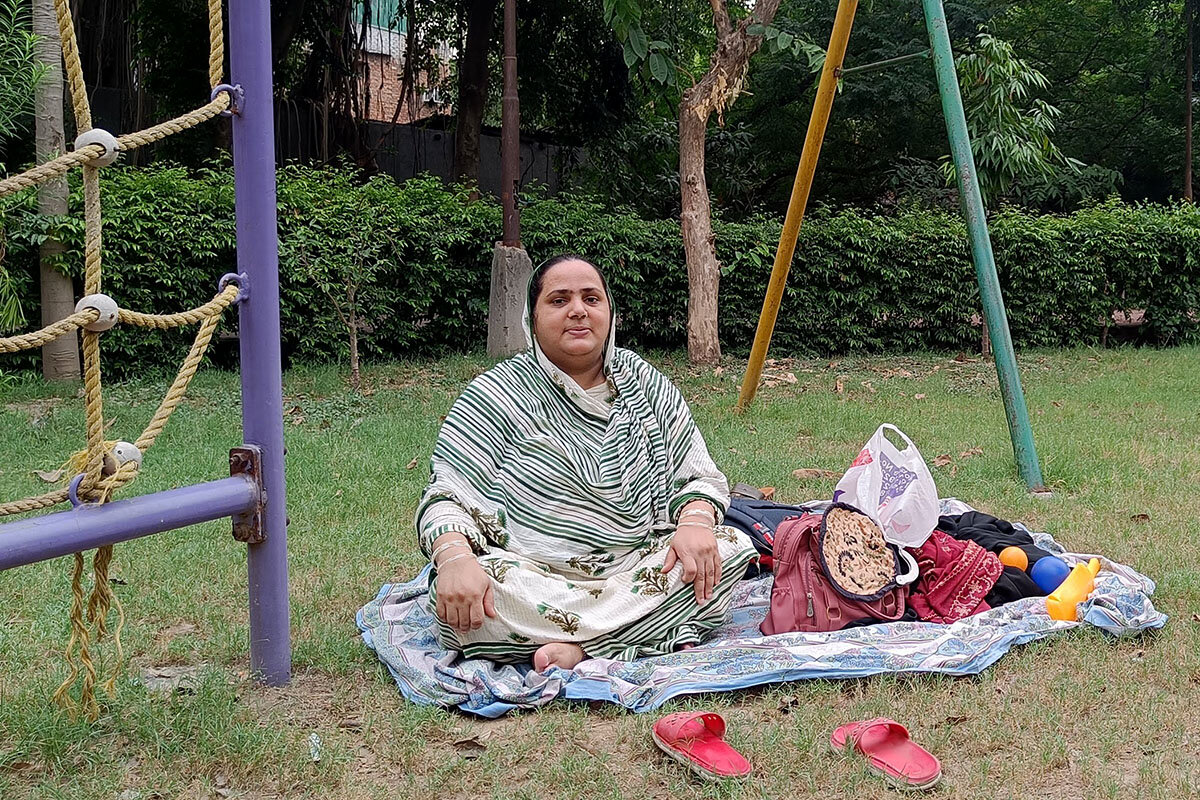
In 2012, a brutal gang rape of a young woman on a moving bus in Delhi sent shock waves across the world and made the city notorious for being unsafe for women. Nearly a third of all crimes against women in metropolitan cities in India take place in Delhi, according to data from India’s National Crime Records Bureau. Resident Madhu Goyal says she never takes a cab by herself. She’s even stopped going to India Gate, a popular landmark in central Delhi, to avoid street harassment. Inside regular parks, she has encountered men who are drunk or taking drugs. “We need more women-only parks so that we too can enjoy” the outdoors, Mrs. Goyal says.
Gender-segregated spaces aren’t new for Delhiites. The first coach of the Delhi metro is reserved for women, and regular commuter Shyamala Kumar says she prefers riding there, even outside of rush hours. A few years ago, Delhi also got its first women-only liquor store.
But more segregation can leave women with little confidence to negotiate public spaces on their own, says Amita Sinha, a retired professor of landscape architecture at the University of Illinois Urbana-Champaign.
“Separate does not mean equal,” she says. “This kind of fragmenting of the public space along gender lines means nobody is a winner.”
It also excludes other vulnerable groups, such as transgender people, notes Syeda Jenifa Zahan, an urban studies researcher at the Polytechnic University of Turin, in Italy.
“Violence against women is used as a sort of logic to create much more exclusion,” says Dr. Zahan, “and then the actual reason, which is this neoliberal patriarchal system that needs to be dismantled, that doesn’t get done.”
Instead of addressing the root cause of the problem, protectionist measures are imposed on women, she explains. They are told not to go out at night or to not wear short clothes for their own safety. It’s why most Indian hostels have nighttime curfews for girls, but not for boys.
Dr. Zahan says it’s possible that in the future if a woman is assaulted at a regular park, she may be blamed for being in a mixed-gender space, instead of going to the park designated for women, thus reinforcing victim-blaming culture.
“There’s an unspoken assumption that a loitering woman is up to no good,” write the authors of the book Why Loiter? Women and Risk on Mumbai Streets. “What women need in order to maximize their access to public space as citizens is not greater surveillance or protectionism (however well-meaning) but the right to take risks.”
Yet despite its pitfalls, Dr. Viswanath says the government’s proposal for pink parks is sparking a conversation about who gets to enjoy public spaces, which in India, are overwhelmingly male-dominated.
Designing gender-inclusive spaces
In her research, Dr. Viswanath has found that there is one thing that makes women feel safe in public spaces more than anything else – having more women around. That can be done, she says, by ensuring that public spaces are well lit at all times and that sidewalks are not broken or dirty, and by providing space for female vendors.
Some of this work is already being done: In 2019, Delhi made public bus rides free for women, and female ridership has grown since.
Another urban design concept for building women-friendly spaces is called “eyes on the street.”
“That is basically [asking], ‘When I stand on the street, can I be seen?’” explains Dr. Viswanath. When she first started doing safety audits in Delhi in the early 2000s, she says the city’s bus stops looked different. The area behind the bus stop was dark, and people’s view was obstructed by a metal structure that extended down from the roof of the shelter. Today, that structure doesn’t reach all the way to the ground, Dr. Viswanath explains, so anyone can see what’s happening behind the shelter.
Good last-mile connectivity is also important to help women feel safer traversing Delhi’s streets, says Dr. Viswanath.
But while urban design can help facilitate social change, it cannot by itself spark it, says Professor Sinha. That, she says, requires a concerted community effort and political will.

Points of Progress
New species and a deep dig into Earth
In our progress roundup, scientists delve deep below the ocean floor and across the biodiverse terrestrial hot spots of Southeast Asia. When these researchers use words like “dream” and “wonder,” their work can inspire us, too.
-
By Ali Martin Staff writer
New species and a deep dig into Earth
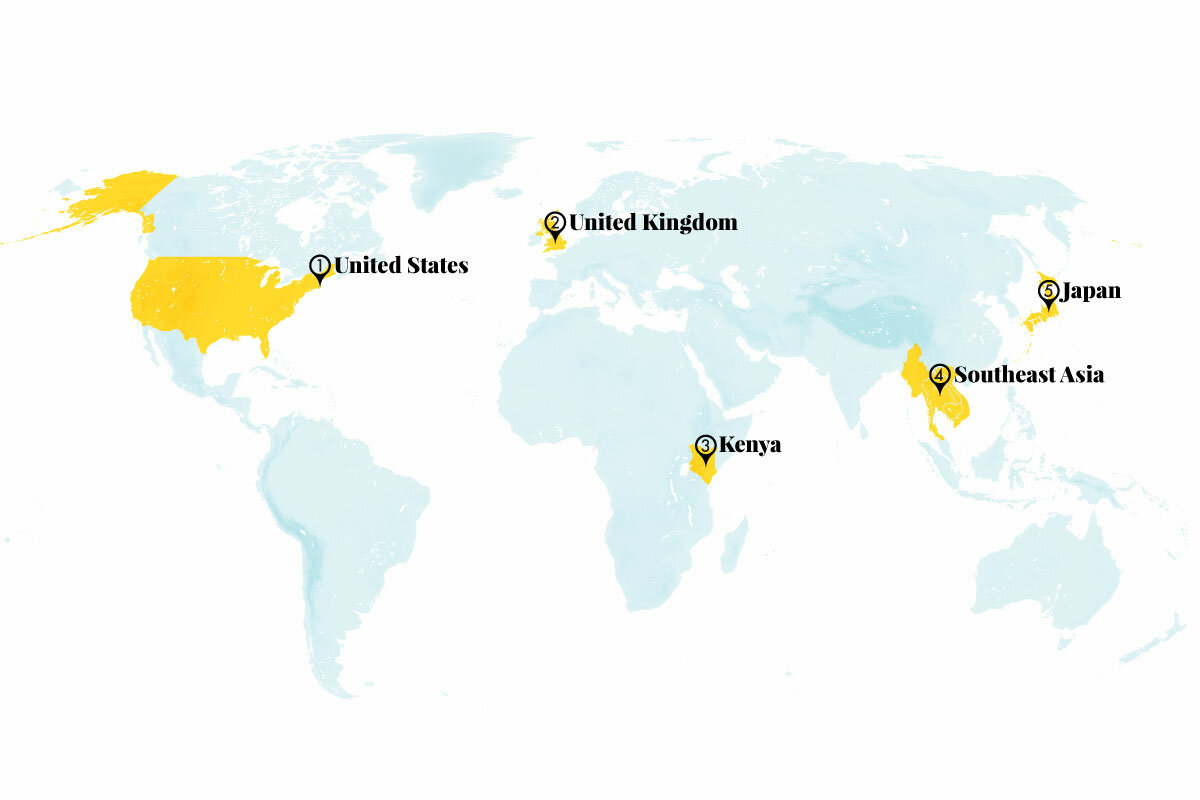
1. United States
Scientists have dug up a significant length of rock from the Earth’s mantle for the first time. The achievement will help geologists study how volcanoes work via the substance that makes up 84% of the planet’s volume. The mantle begins about 5 miles below the ocean floor and 20 miles beneath continents.
The team of geoscientists, led by Andrew McCaig from the University of Leeds in England and Susan Lang with Woods Hole Oceanographic Institution, set out to explore microbes trapped in rock beneath the ocean that could shed light on Earth’s earliest life forms.
They drilled into an underwater mountain in the North Atlantic where mantle rocks have pushed relatively close to the surface – creating a “tectonic window” – and pulled up long samples from as deep as 4,157 feet below the ocean floor.
“We’ve achieved an ambition that’s been feeding the science community for many decades,” said Dr. McCaig.
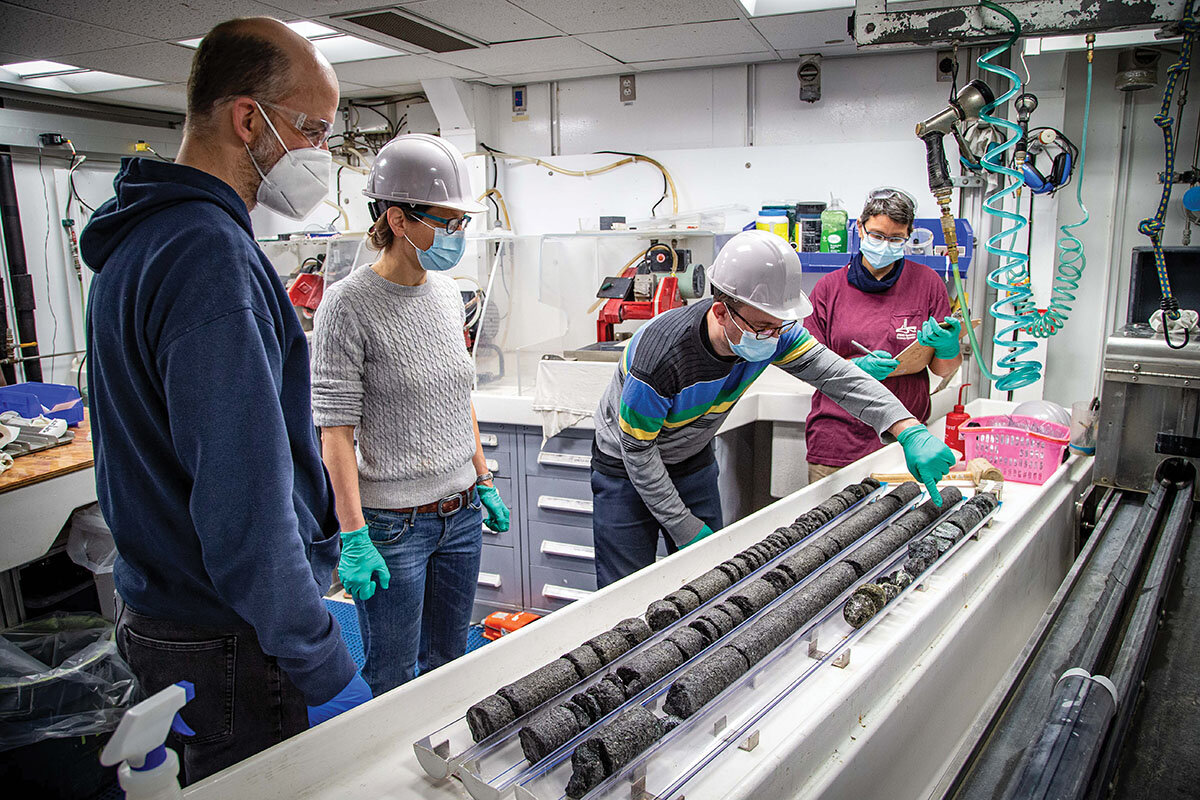
Scientists know from samples ejected by volcanic eruptions that the mantle is made up mostly of peridotite, which dominated the newly drilled cores. They are working to determine how representative these samples are and how seawater may have contaminated them.
Sources: The Washington Post, Science
2. United Kingdom
Innovators in the United Kingdom are making strides toward zero-emissions flight. A hydrogen-electric-powered Dornier 228 flew for 10 minutes in January – the first such flight for a larger, 19-seat plane.
Several airlines – and Amazon – have invested in ZeroAvia, which is developing the hydrogen-electric powertrain to replace traditional engines. Airlines have preordered 1,500 of the new engines, which will be used for shorter, regional routes and cargo flights. The company is also working to encourage airport infrastructure that accommodates on-site fuel production, and with companies that can make green hydrogen that leaves no carbon footprint.
The aviation industry contributes over 2% of the world’s CO2 emissions but has pledged to reach net-zero carbon emissions by 2050.
“The technology will get there,” said ZeroAvia CEO Val Miftakhov. “Whether it’s through incentives for zero emissions, or disincentives for fossil fuel, I think it can be done.”
Sources: Fast Company, International Energy Agency, Zeroavia
3. Kenya
Kenya is expanding programs that invite local input to address climate change, reducing the risk of maladaptation – when intended solutions are more harmful than helpful. Kenya launched its Adaptation Consortium in 2010 after a reservoir commissioned by Nairobi disrupted grazing patterns – a problem that could have been avoided by consulting local herders. The loss of grazing increased the risk of drought instead of abating it, and the reservoir was replaced by a well that better suited local needs.
More than a decade later, success of the Adaptation Consortium in five counties spurred demand from the rest of the country. In 2021, the Financing Locally Led Climate Action Program – backed by the World Bank and supporting countries – launched with the goal of reaching all of Kenya’s 1,450 wards. The idea also follows the general devolution of government control to 47 counties, following directives in Kenya’s 2010 Constitution to decentralize the government.
A 2022 United Nations report said that wealthy nations set aside $29 billion to help developing countries adapt to climate change – five to 10 times less than what is needed by 2030.
Communities can organize to “participate in the climate process in terms of identifying and prioritising where to invest the climate funds,” said Victor Orindi, national coordinator of the Adaptation Consortium.
Sources: Context, World Bank
4. Southeast Asia
Researchers discovered 380 new species living in Cambodia, Laos, Myanmar, Thailand, and Vietnam. Hundreds of contributors compiled a World Wildlife Fund (WWF) report detailing 46 reptiles, 24 amphibians, 19 fishes, 290 plants, and one bat from the Greater Mekong region from 2021 to 2022. Some of the work spanned generations: In one case, a plant collected in the 1930s was just confirmed as a novel species.

Highlights include a miniature, bright pink and yellow orchid named Dendrobium fuscifaucium that was discovered in Laos; a Cambodian blue-crested agama, an aggressive lizard that changes color when threatened; a type of splendid perch found off the coast of Myanmar, with a larger head, differently shaped tail, and bright coloring that is distinct from other perch; and two different toads endemic to Thailand. The Karen stream toad, found in western Thailand’s Tenasserim mountains, was named for the local Karen people who supported researchers. The tiny, reddish-orange Ansonia infernalis lives in fast-moving streams on the Thai-Malay Peninsula and is less than 30 millimeters long.
While exciting for experts, the discovery comes with a reminder of the variety of threats facing biodiversity. “We must continue to invest in the protection and conservation of nature,” said WWF-U.S. Asian species manager Nilanga Jayasinghe, “so these magnificent species don’t disappear before we know of their existence.”
Sources: Nice News, World Wildlife Fund
5. Japan
Vending machines are aiding disaster preparedness in Japan. Selling items for payment under normal circumstances, the machines are programmed to dispense food and emergency supplies free of charge if a major earthquake or typhoon strikes. Holding about 300 soft drinks and 150 food items, two of the machines were installed by the local government near evacuation shelters in Ako, on the western coast.
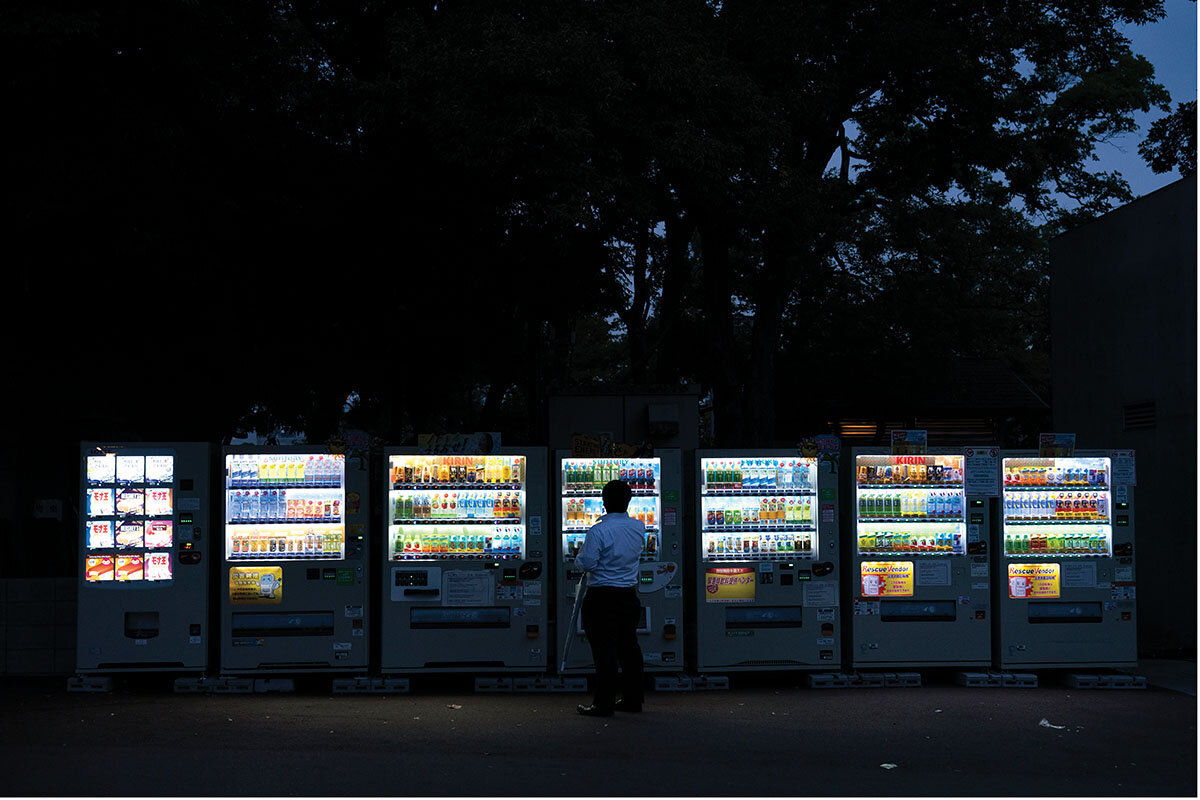
In Tokyo, a different, radio-equipped vending machine will broadcast alerts for earthquakes, with evacuation and other emergency information. At least 30 local radio stations have set up similar vending machine radios across the country.
Japan has the most vending machines per capita in the world and thousands of earthquakes every year. It sits in the circum-Pacific seismic belt, where 81% of the world’s largest earthquakes take place.
Sources: The Guardian, The Mainichi
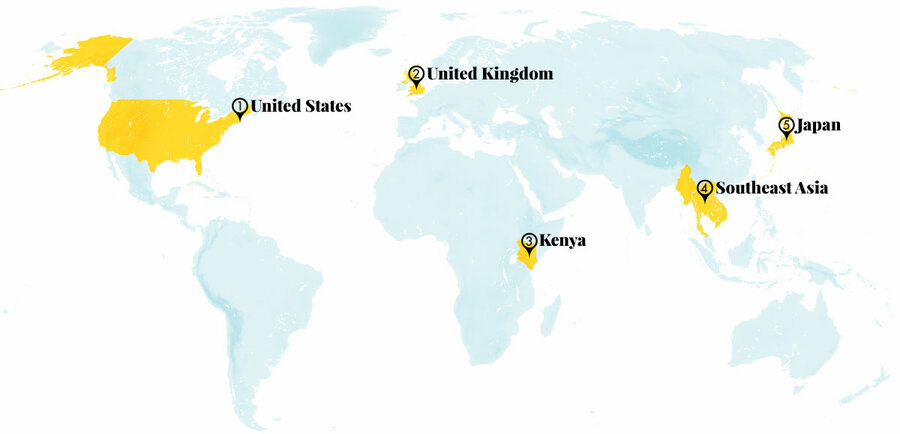
Other headline stories we’re watching
(Get live updates throughout the day.)The Monitor's View
In climate extremes, opportunities for deeper reflection
- Quick Read
- Deep Read ( 2 Min. )
-
By the Monitor's Editorial Board
With greater weather disruptions this year, scientists are ever more eager to understand what drives people to keep warming the atmosphere. A study published today by World Weather Attribution, for example, found a link between human activity and the floods, wildfires, and record-breaking heat waves now affecting people from Phoenix to Beijing. That link clearly turns the global discussion on climate change toward a deeper dimension. A growing number of experts are asking whether people might be changing their core beliefs.
“The solution to climate change ... [doesn’t] seem to lie in technological innovation or climate modeling (not to negate their importance), but rather, in something within humanity itself,” Jessica Eise, a professor of social and environmental challenges at the University of Texas at San Antonio, wrote in the journal Sierra last month. “Hope? A sense of connection? Of being loved, and loving in return? Could spirituality save us?”
For decades, the fear of climate change led to inaction and blame. A new era may be emerging, one that rests on seeing Earth and all life connected and cared for by the highest quality of thought.
In climate extremes, opportunities for deeper reflection

With greater weather disruptions this year, scientists are ever more eager to understand what drives people to keep warming the atmosphere. A study published today by World Weather Attribution group, for example, found a link between human activity and the floods, wildfires, and the record-breaking heat waves now affecting people from Phoenix to Beijing. That link clearly turns the global discussion on climate change toward a deeper dimension. A growing number of experts are asking whether people might be changing their core beliefs.
“The solution to climate change ... [doesn’t] seem to lie in technological innovation or climate modeling (not to negate their importance), but rather, in something within humanity itself,” Jessica Eise, a professor of social and environmental challenges at the University of Texas at San Antonio, wrote in the journal Sierra last month. “Hope? A sense of connection? Of being loved, and loving in return? Could spirituality save us?”
The questions Dr. Eise poses arise from her research into the shifting attitudes among Americans who regard themselves as deeply spiritual despite rejecting organized religion. While only 38% of her subjects think “people are stewards of nature,” 59% think that “people are a part of/one with nature.” She argues for a rethinking of science on the basis that Earth and all life are united and cared for.
That view coincides with what the Graduate Theological Union, a partner institute with the University of California, Berkeley, calls “green spirituality” – “ways of knowing that are embedded in religion, philosophy, spiritual ethics, moral traditions, and a culture that values the community and the commons.”
In some of the world’s cities most vulnerable to extreme heat, those values are already reshaping responses to climate change. An expanding network of “chief heat officers” is sharing and implementing new urban designs rooted in compassion for those most vulnerable to weather disruptions – children, women, and those without homes. “Social resilience is important for any kind of difficult scenarios that we’re gonna face in the future,” Eleni Myrivili, global chief heat officer to U.N.-Habitat, told NPR last week.
In the aftermath of torrential rains that flooded parts of Vermont this month, environmental writer Bill McKibben wrote a passage in The New Yorker that shows how humanity may be working out this problem by degrees. The incredible warming of these current weeks, he wrote, should “remind us how valuable a breeze is, how remarkable a deep-blue winter day, or how precious the cool that comes when night falls. ... This planet remains stirringly beautiful, and that beauty must be one of the things that moves us to act. And so must the beauty that people can produce” – such as panels that safely harness the power of the sun.
For decades, the fear of climate change led to inaction and blame. A new era may be emerging, one that rests on seeing Earth and all life connected and cared for by the highest quality of thought.

A Christian Science Perspective
Each weekday, the Monitor includes one clearly labeled religious article offering spiritual insight on contemporary issues, including the news. The publication – in its various forms – is produced for anyone who cares about the progress of the human endeavor around the world and seeks news reported with compassion, intelligence, and an essentially constructive lens. For many, that caring has religious roots. For many, it does not. The Monitor has always embraced both audiences. The Monitor is owned by a church – The First Church of Christ, Scientist, in Boston – whose founder was concerned with both the state of the world and the quality of available news.
God’s love and care – never lost
- Quick Read
- Read or Listen ( 3 Min. )
-
By Dilshad Khambatta Eames
Recognizing that God, infinite Love, can never lose sight of His children brings inspiration, joy, and healing.
God’s love and care – never lost
So many today are dealing with a sense of loss – perhaps the loss of companionship, health, financial stability, or purpose.
The teachings of Christ Jesus offer deep insights into everyone’s innate wholeness and value, found in God – who is described in the Bible as divine Love itself. For instance, he relates a parable about a shepherd who sets out to find one lost sheep out of his flock of 100. This speaks to God’s tender protection for all of us as His children – even if it seems we’ve ignorantly wandered away from His care and safety.
God, being ever present, tenderly lifts us up and gently places us on His own “shoulders,” safely bringing us home to the knowledge of Love’s infinite care. Divine Love’s purpose is to make itself known to all, and this omnipresent Love can never be lost or lose sight of us.
Really appreciating this parable in a spiritual light has grown my understanding of everyone’s inseparability from God. Our heavenly Father has provided for us our true, spiritual identity as His own reflection – entirely spiritual, cared for, and whole. Through spiritual sense we can tangibly feel this oneness with God. And we can never lose our innate spiritual sense because it flows from the great giving heart of Love itself.
The only thing we can and must lose is a false sense of ourselves as material, mortal. This is the truth that Jesus proved through his healing ministry, and which we can put into practice, too.
Several years ago I was going through a time of change in my life that brought with it a sense of sadness and loss. I also began experiencing unnatural hair loss.
I’ve found Christian Science to be the most effective way for true and permanent healing, so I made a conscious decision to turn wholeheartedly to God. I also humbly asked a Christian Science practitioner to pray for me in support of my desire to lean on God to heal this discordant situation. Even though the disappointment and dread I was feeling seemed overwhelming, I knew I could depend more fully on God.
As I conscientiously prayed with the weekly Bible Lesson found in the “Christian Science Quarterly” – digging into the Bible and “Science and Health with Key to the Scriptures” by Mary Baker Eddy – I regained a sense of hope. The fear started to dissipate. Within a few days, my joy had returned, and I was completely free from the physical problem.
This healing brought about a deeper lesson about the might of having the humility to more fully depend on God – the source of our being – and on Christ, Truth. Such humility isn’t about being a doormat, so to speak. On the contrary, an important aspect of true humility is actively, wholeheartedly turning to God for a deepening conviction of what can never be lost: our identity as God’s children, His spiritual expression – precious and deeply valued – and our purpose to bear witness to God’s goodness and glory, reflected in ourselves and everyone.
In this way we can humbly trust our Shepherd, yield to divine Love, and feel our oneness with God. We can let Love lead us “home” to a recognition of our God-given joy and wholeness – and rejoice in this homecoming! When the action of divine Love transforms our thoughts and uplifts our heart, we can feel more fully our “spotless purity and original perfection” (Mary Baker Eddy, “The First Church of Christ, Scientist, and Miscellany,” p. 262).
Each of us is wholly spiritual. Nothing spiritual can ever be lost, because what God, infinite Spirit, creates is eternal. As God’s reflection, we are held complete and perfect in God, sustained by the unchangeable law of divine Love. And this realization brings true healing, regeneration, and progress.

Viewfinder
A monument for Emmett and Mamie

A look ahead
We hope you enjoyed today’s Monitor Daily. Tomorrow, we’ll bring you a story about changing views of immigration in Britain. While the topic is still tying the ruling Conservative Party in knots, it is less controversial than it once was. A new, moderate consensus is building in favor of “controlled openness.”


